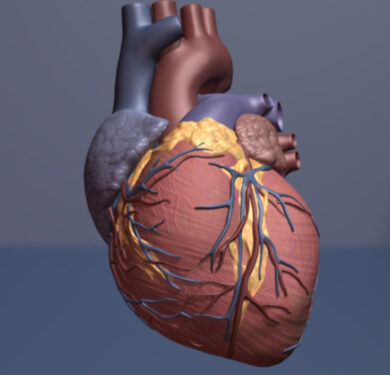Human heart. Credit: Copyright American Heart Association
A research team has discovered a possible therapeutic target for pulmonary hypertension. The study, published in the journal Scientists progressidentifies the first scalable therapeutic target to preserve cardiac function in pulmonary hypertension, providing hope in the fight against this rare but deadly disease for which there is currently no cure.
Pulmonary hypertension is a condition of high blood pressure in the arteries that carry deoxygenated blood to the lungs. This increase in pulmonary artery pressure puts continued pressure on the heart because it has to work harder to pump blood to the lungs.
Pulmonary hypertension affects between 15 and 50 people per million inhabitants worldwide. In Spain, the estimated prevalence is 1.6 cases per 100,000 inhabitants and the estimated incidence (new cases diagnosed per year) is 0.3 per 100,000 inhabitants.
The disease produces symptoms that can seriously affect quality of life, including shortness of breath, dizziness and fainting. In severe cases, patients may need a transplant to avoid death.
Risk factors for developing pulmonary hypertension include smoking, being overweight, a history of related diseases, genetic predisposition, and prolonged exposure to low atmospheric oxygen at high altitudes.
Currently available treatments target the lungs and aim to lower blood pressure. However, these strategies do not improve heart function, making heart failure the leading cause of death in these patients.
The researchers, led by Dr. Guadalupe Sabio of the Centro Nacional de Investigaciones Cardiovasculares (CNIC) in Madrid, found that patients with chronic obstructive pulmonary disease (COPD) had elevated levels of a mitochondrial protein called CJD.
The first author, Ayelén M. Santamans, observed that CJD was also elevated in mice exposed to low oxygen levels and in pigs with induced heart damage. “These results therefore suggest that the MCJ protein could be involved in pulmonary hypertension. The lack of cardio-specific treatments for this disease encouraged us to pursue this line of research.”
The study results demonstrate that modulating CJD levels in the heart can preserve cardiac function despite the presence of lung injury.
This protection is a consequence of the activation of a signaling pathway essential for adaptation to low oxygen levels, which prepares the heart to function properly in the absence of oxygen.
The authors conclude that these results could pave the way for therapeutic interventions against pulmonary hypertension, as they identify the first target whose modulation can preserve cardiac function in this deadly disease.
More information:
Ayelén Santamans et al, MCJ: A mitochondrial target for cardiac intervention in pulmonary hypertension, Scientists progress (2024). DOI: 10.1126/sciadv.adk6524. www.science.org/doi/10.1126/sciadv.adk6524
Provided by the Centro Nacional de Investigaciones Cardiovasculares Carlos III (FSP)
Quote: Scientists discover first therapeutic target to preserve heart function in patients with pulmonary hypertension (January 19, 2024) retrieved January 19, 2024 from
This document is subject to copyright. Apart from fair use for private study or research purposes, no part may be reproduced without written permission. The content is provided for information only.



